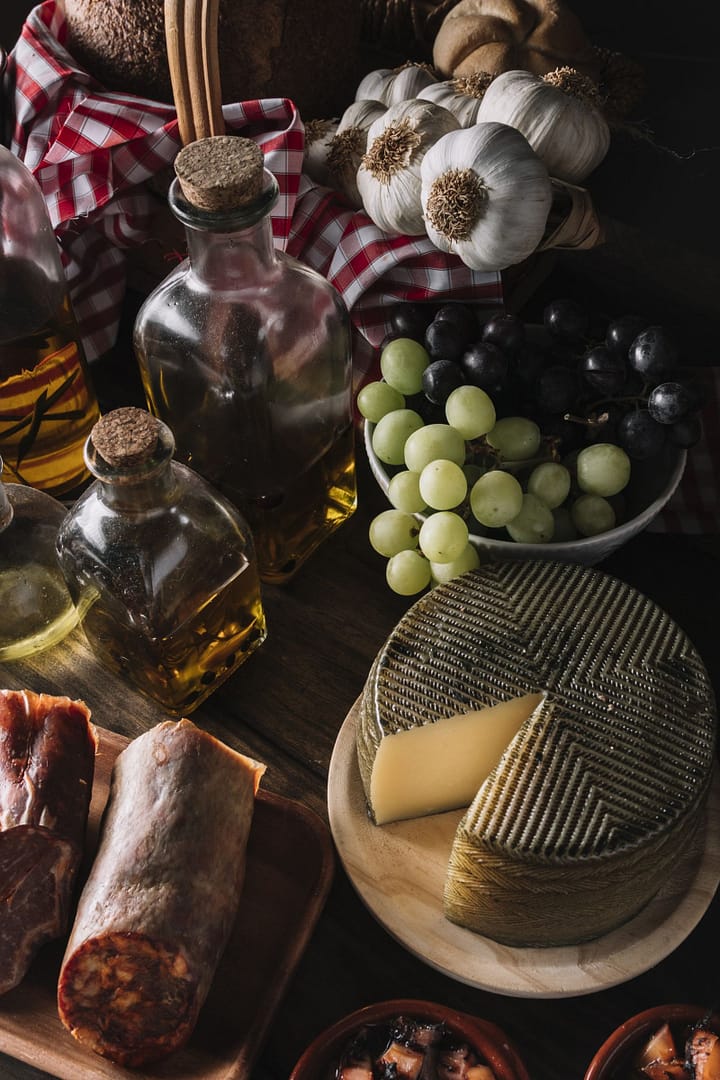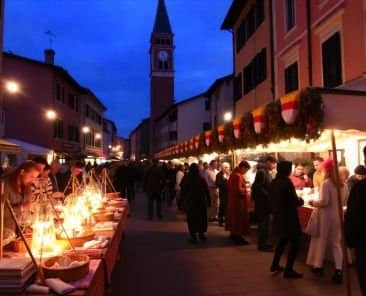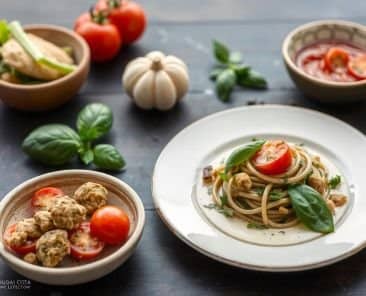Known for its cuisine, which draws inspiration from the region’s seafood, meats, and vegetables, in Veneto you’ll find a mouthwatering selection of unique and healthy dishes.
Veneto’s environment is what contributes to the varied gastronomic offerings. In fact, each dish tells a story from the region’s past, and this is what makes the culinary experience even more memorable.
The focus on using seasonal flavours sets Veneto’s cuisine apart, and it can be experienced in both the quaint trattorias of Verona and through the use of fresh, locally produced products and creative cooking methods.
In the coastal towns and cities of Veneto, dishes like Sarde in Saor and Risotto al Nero Di Seppia highlight the region’s seafood wealth and culinary artistry. Meanwhile, the fertile plains and mountains of Veneto serve as the backdrop for hearty meat-based dishes like Fegato Alla Veneziana and Pastissada De Caval, which highlight the rich cooking traditions and rustic flavours of the region.
Seafood
Traditional Veneto dish
Veneto is renowned for a wide variety of inventive and healthy dishes that showcase the area’s dedication to whole foods and mindful dining. Veneto’s cuisine has something to suit every taste and preference, from Cicchetti, which are bite-sized appetizers not dissimilar to the Spanish concept of tapas, to Polenta, a flexible cornmeal staple that makes the ideal companion to savoury stews and sauces.
Traditional Veneto dish
Culinary Characteristics
Culinary in Veneto is influenced by worldwide cuisines. That’s why the flavours are so diverse and unique. It is also influenced by the flavours of the Mediterranean and the spices of the East, giving its dishes more depth and taste.
The primary sources of carbohydrates in Veneto’s gastronomy are polenta and risotto, which are favoured over pasta. A favourite Venetian staple, and historically the mainstay at every meal in poor households, polenta is a flexible dish with cornmeal commonly served as a side dish to savoury stews, braised meats, and robust sauces.
Similarly, versions of Risotto that highlight regional delicacies like shellfish, mushrooms, and seasonal vegetables highlight the culinary artistry and attention to detail of the Veneto region.
Polenta
Risotto
Even though Veneto has a variety of traditional foods, some of its culinary specialities might surprise visitors from other countries. Although they are a part of Veneto’s culinary legacy, dishes like horse, tripe, and donkey are not always available on menus and may not be to everyone’s taste.
In conclusion, the distinctive culinary features of Veneto are evidence of the region’s rich cultural legacy, variety of influences, and innovative spirit.
Iconic Dishes
Carpaccio
Carpaccio is a popular Venetian dish made up of thin slices of raw meat, usually beef or fish, seasoned with lemon juice, olive oil, salt, and pepper. Carpaccio has its roots in the famous Harry’s Bar in Venice, which was founded by the renowned Giuseppe Cipriani in 1963. The name of the meal, Carpaccio, honours Venetian painter Vittore Carpaccio, who was renowned for his vivid crimson tones, reflecting the rich hues of the dish. Because of its delicate texture, subtle flavours, and beautiful presentation, Carpaccio is a must-try for picky food enthusiasts. To cater to increasing vegan interest, carpaccio is nowadays also occasionally served as a sliver of beets or other suitable vegetables.
Risotto all’Amarone
The pride of Verona, Risotto all’Amarone is a culinary masterpiece that perfectly captures the depths of flavour and traditions found in Veneto. The chefs highly value locally-grown Vialone Nano rice for its smooth texture and resistance to sogginess when making this risotto. It also contains the powerful flavour of Amarone wine, a sought-after red wine from the Valpolicella hills. This recipe, which is enhanced with Monte Veronese cheese, and slow-simmered to perfection, tempts the palate with its rich and creamy flavour.
Sarde in Saòr
This is another dish whose roots lie in the seafaring history of the Venetian Republic. Like other dishes like pan biscotto, it was born out of the necessity to preserve food for long sea voyages.
Venetian cuisine holds Sarde in Saòr as a beloved symbol, made by delicately marinating freshly caught sardines in vinegar, olive oil, onions, raisins, pine nuts, and fragrant herb-based sweet and sour sauce. Sarde in Saòr has become a cherished treat appreciated for its nuanced flavours and cultural importance. With every mouthful, the sauce whisks guests away to the shores of Venice, where the scents of the sea blend with the vivid spices of the Mediterranean to create a remarkable gastronomic experience.
Polenta
Once a modest mainstay of Venetian cuisine, Polenta has gained popularity as a delicious and adaptable dish that is enjoyed by both residents and tourists. Polenta, which was formerly dubbed a poor people’s alternative to bread is a creamy porridge made from coarsely powdered cornmeal cooked in water or broth.
Today, there are many ways to enjoy polenta. There is the classic soft and creamy version that is served as a side dish with Baccalà (salt fish) or grilled meats, or there is the firm, cooled-down version that is sliced and then grill-perfected to provide a delicious juxtaposition of flavours and textures.
Baccalà
Venetian cuisine places a great deal of value on Baccalà, or salt fish, because of its flavour and adaptability. During the Middle Ages, Venetian cuisine relied heavily on salt cod, which was brought in from the North Atlantic and valued for its inexpensive and extended shelf life. There are many other ways to cook Baccalà, ranging from the traditional Baccalà mantecato (creamy whipped salt cod) to Baccalà alla Vicentina, cooked in milk and cheese. Whether eaten as a classic Venetian dish or in a more contemporary version, Baccalà is a well-liked representation of the region’s marine history and culinary skill.
Regional Cuisine
Venice
Venice is a city well-known for its picturesque canals and rich cultural legacy and has a thriving food scene that is distinguished by its focus on succulent Risotto dishes, delicious Cichéti (small bites), and fresh seafood. In Venetian cuisine, seafood is the main course, and the Adriatic Sea offers an abundance of fresh fish and shellfish. Risi e Bisi, a creamy risotto with peas, and Baccalà Mantecato, a whipped salt cod spread served over buttered bread, are two popular dishes in Venice. Risotto al Nero di Seppia, a risotto flavoured with cuttlefish ink and distinguished by its deep black hue and flavour, is another well-known dish.
Belluno
Belluno, which is tucked away in the stunning Dolomites Mountain range, offers a distinctive alpine cuisine that honours the abundance of the local environment. Rich in cheese and game, Belluno’s culinary specialities include Schiz cheese, a semi-hard cheese with a unique nutty flavour, and Pastin sausage, a flavourful sausage produced with meats and seasoning that are sourced locally. Another popular meal is Casunziei Ravioli, which is filled with a flavourful beetroot and ricotta cheese mixture. This dish offers a beautiful blend of salty and sweet flavours that perfectly reflect the essence of the rocky scenery of Belluno.
Schiz cheese
Casunziei Ravioli
Treviso
Treviso’s is a beautiful province renowned for its picturesque vineyards and green scenery. It is also recognized for its lively culinary customs, which revolve around Prosecco wine, Grana Padano cheese, and Radicchio. The bitter leafy vegetable Radicchio is a mainstay of Treviso cuisine, showing up in recipes like Radicchio Risotto, where its unique flavour gives the creamy rice dish more depth and complexity. Treviso is well-known for its dessert, Tiramisu, a divine blend of mascarpone cheese, cocoa powder, and lady fingers steeped in coffee. Both locals and tourists adore it for its creamy richness and tempting flavour.
Vicenza
Vicenza’s food scene honours the region’s rich agricultural heritage and handicraft customs. Asiago cheese, with a nutty flavour and a creamy texture, is a well-liked local treat that goes well with crusty bread and regional wines. Baccalà alla Vicentina is another delectable dish that is made by patiently simmering salt cod in a flavourful sauce made with milk, onions, and olive oil until it becomes soft and aromatic. In addition to these well-known dishes, Vicenza is renowned for its beautiful white asparagus, which is grown in the spring and used in recipes that accentuate its delicate texture and mild flavour. In addition to these gastronomic delights, Vicenza is well known for its Grappa, a grape-based alcohol that experts age and distil to perfection, resulting in a deep and aromatic flavour profile.
Asiago cheese
Verona
Verona’s diverse range of cultures and long history are greatly reflected in its cuisine. The city is well-known for its Amarone wine, a robust and complex red wine produced from dried grapes that gives many classic foods a deeper, richer flavour. Brasato all’Amarone, a thick succulent beef stew cooked in a rich Amarone wine sauce, is a prime example of Verona’s culinary craftsmanship and appreciation for fine wine and food pairings. Verona’s Pandoro cake is a popular holiday dessert with a golden coating and light, fluffy texture representing the city’s rich culinary legacy and festive spirit, is another must-try for anyone with a sweet taste.
Brasato all’Amarone
Pandoro cake
Rovigo
The coastal cuisine of Rovigo celebrates the vast marine and agricultural resources of the region. Frittura di Pesce, a wonderful mix of fried and lightly battered seafood, is a famous meal that perfectly embodies the maritime heritage of Rovigo. This dish highlights the freshness and quality of the seafood in the area, with flavours ranging from savoury fish fillets to soft shrimp and crispy calamari. In addition to fish, Rovigo’s cuisine highlights regional characteristics by incorporating locally farmed grains, vegetables, and herbs into many of its recipes. A delightful taste of Rovigo’s culinary tradition and seaside charm, Frittura di Pesce is perfect for a leisurely supper by the sea or a casual street food snack.
Fritture di Pesce
Padua
Padua’s culinary tradition is rooted in simplicity, with a focus on hearty, rustic dishes that highlight the region’s agricultural heritage and seasonal ingredients. A staple of Paduan cuisine, White Polenta is made from finely crushed cornmeal and is served as a creamy side dish to savoury stews, braised meats, and delicious sauces. Oca in Onto, a speciality of the region, requires cooking geese in their fat until they turn soft and savoury, resulting in a luxurious and indulgent dining experience. Padua’s food symbolizes the warmth and hospitality of the region, enabling guests to taste the genuine flavours of Veneto’s countryside with its emphasis on quality ingredients and traditional cooking methods.
White Polenta
Oca in Onto
Noteworthy Ingredients
Rice
In Veneto, rice is a staple ingredient with one particular variety, Vialone Nano Veronese, standing out as a favourite among locals and chefs alike. Small, spherical grains of Vialone Nano Veronese rice are highly valued for their capacity to absorb flavours while maintaining a solid texture, which makes it perfect for soups, risottos, and other classic recipes.
Rice
In Veneto, rice plays a starring role in many iconic recipes, including Risotto all’Amarone, a creamy rice dish filled with the robust tastes of Amarone wine, and Risotto al Nero di Seppia, a savoury risotto prepared with squid ink. Rice is also used to make traditional Venetian desserts like Rice Cake made with rice, eggs, sugar, and lemon zest.
Polenta
When exploring the culinary landscape of Veneto, one cannot overlook the significance of polenta, a versatile and beloved ingredient that has been a cornerstone of the region’s cuisine for centuries. Polenta, a beloved Venetian dish, is made with coarsely ground yellow or white cornmeal and is praised for its warm appeal, adaptability, and simplicity.
The fact that polenta can be consumed in both liquid and solid forms, each providing a distinctive flavour, is one of its most notable features. When made in liquid form, polenta is made by slowly heating cornmeal with water or broth until it becomes creamy. This dish can be used as a foundation for many different savoury recipes, including saucy Ragùs, substantial stews, and braised meats. When cooked and cooled, polenta solidifies into a harder texture that makes it ideal for slicing into cakes or wedges that can be baked, fried, or grilled to perfection.
Polenta
Cheese
Cheese is undoubtedly a notable element in Veneto cuisine, and the region produces a wide variety of well-known cheeses that are acclaimed by both domestic and foreign palates. Grana Padano, Asiago, Piave and Montasio are among the most well-known cheeses in Veneto; they all have unique flavours, textures, and culinary applications that add to the region’s diverse culinary traditions.
Provolone Valpadana
Grana Padano
Wine and Spirits
It is hard to ignore the Veneto region’s long history of producing wine and spirits while savouring its delicious cuisine. Veneto is known across the world for its legendary local spirit, Grappa, and its superb wines, which include Amarone, Bardolino, Soave, and Prosecco. These drinks are a testament to the excellence of Veneto’s terroir as well as the region’s commitment to skill, heritage, and innovation in the fields of distillation and viticulture.
Amarone
Veneto is renowned not only for its excellent wines but also for Grappa, the region’s signature alcoholic beverage. Made from residual grape skins, seeds, and stems known as pomace, Grappa is a rich, aromatic spirit with a strong, unique personality. Grappa is typically used as a digestif, but it can also be added to cocktails and food preparations to give flavours and texture depth.
Bardolino
Overall, Veneto’s wines and spirits bear witness to the region’s rich history of winemaking, terroir, and commitment to excellence and workmanship. Enjoying a glass of Amarone with a filling meal, sipping Prosecco as a toast, or sipping Grappa post-dinner, Veneto provides an abundance of flavours and sensations that entice the senses and honour the craft of distillation and winemaking.
Conclusion
Veneto’s gastronomy is definitely worth exploring. But then again, it’s no surprise; it’s Italy, after all! The home of tasty food and cultural traditions.
Food lovers from all over the world come to experience the mouthwatering flavours and gastronomic riches of Veneto, a region known for its emphasis on using only the freshest, locally produced products, traditional recipes, and friendly hospitality. And this is your sign that you must, too!
Was this helpful?
Good job! Please give your positive feedback
How could we improve this post? Please Help us.


















